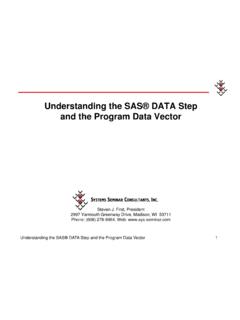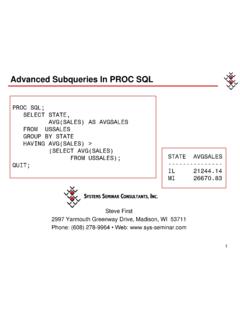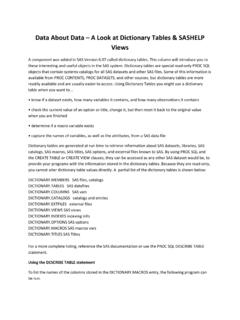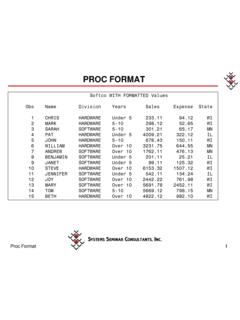Transcription of Tip #1 – 3 Methods of Commenting Out Unused …
1 Tip # 1 3 methods of commenting out unused code . In SAS there are several common ways to comment out code that is not being used. The first two are rather well-known and straightforward. a. Method #1: Using an asterisk to comment out one line of code . data lab; set ; if lbtestcd= CA ; *if lbtestcd= GLUCOSE ; run; b. Method #2: Using /* and */ to comment out sections of code . data lab; set ; /*if lbtestcd= CA then do; lbtest=trim(left(put(lbtestcd,lab.))); end;*/ run; A problem occurs when you want to comment out a larger section of code . In particular, it is difficult to comment out a larger section of code that include multiple occurrences of /* and */. In that case, put the section of code in a macro and then don t call the macro. c. Method #3: Create %macro comment and don t call the macro. data lab; set ; %macro comment; /*staceyp 5/11/06 don t use lab format for LBTEST until format is ready*/ /*if lbtestcd= CA then do; lbtest=trim(left(put(lbtestcd,lab.)))
2 ; end;*/ %mend; /*Use raw codes for LBTEST value*/ if lbtestcd = CA then do; lbtest=lbtestcd; end; run; Tip #2 Tricking Your Automatic SAS Log-checker With User Defined Warnings My project team utilizes a UNIX script that operates as an automatic log checker to search the SAS log for unitialized variables, errors and warnings, etc. Sometimes we want to create our own user-defined log warnings using PUT statements to catch data problems: Example 1 data lab; set ; /*Send warnings to the LOG where data is missing*/ if lbtestcd= then PUT WARNING: subjid= visit= is missing LBTESTCD. ; run; If we were to use the above code , the automatic log-checker would flag the code itself even if the condition weren t true because it searches for the text string WARNING . The solution is to separate the text of WARNING so that it will only resolve to WARNING if the condition is true: Example 2 data lab; set ; /*Send warnings to the LOG where data is missing*/ if lbtestcd= then PUT WAR NING: subjid= visit= is missing LBTESTCD.
3 Run; In the above case, the PUT statement will only resolve if LBTESTCD is missing so the log-checker will not erroneously flag text from the code that is not actually a warning. Printed to the log from the second example: WARNING: subjid=1004 visit=Visit 1 is missing LBTESTCD. Questions? Stacey D. Phillips Senior Statistical Programmer i3 Statprobe 608-277-0194







